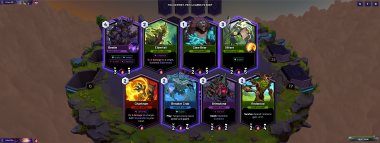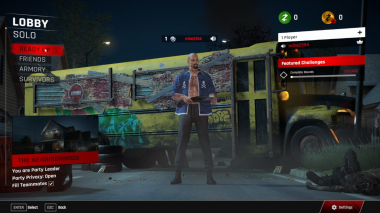The quick answer: when you will get the most publicity! Finding exactly when in the development cycle and year that is, however, can be the tricky bit.
The movers & shakers
Common wisdom says that a potential customer can only see so many products and services before each one only becomes noise. Only so many games can be featured in ads, on the Steam store, or in friends’ recommendations. Having a great game lays the groundwork for success, here, but having fierce competition will drown out your game in noise before it has even been noticed.
Indie games are not largely affected by triple-A releases the same way mid-budget games made by small —even well-established—studios.. A point-and-click narrative adventure will lose few players to a game such as DOOM releasing, after all, as they target different audiences! What is more, while press attention might be diverted to the big AAA releases, it is no secret that “the press doesn’t cover indie games anyway” (HTMAG).
This article will then only apply to indie games, if your game already has more than 50,000-100,000 wishlists, you might need to take every nearby release into account, instead. In that case, your game’s hype will likely trump many of the things discussed from here on!
If a game becomes a hit, the press will flock to it. That becomes the first step then, so just when do we release, if not just to avoid AAA releases?
Macro decisions
Monthly Conversions
As a general case, due to commercial cycles and most companies respecting the fiscal year, a pattern emerges in Steam releases.
The GameDiscoverCo newsletter
Your launch window may be decided by the length of your game development, but if it is still undecided, targeting a time of year that has less global competition for a customer’s dollar will lead to good returns.
As shown, the ending of the October Steam Next Fest through the holidays is the worst time of year to release, and the first two months of the year are superior! June is said by the authors of the study to have been an unreliable result, as it includes games released during the Steam Summer Sale.
Should you release in this sale as they did, in order to maximize your sales? The answer: No!
Things to avoid
Steam-wide sales will divert many people to Steam, who will scour the Steam store only as far as their recommendations and wishlists. While increased traffic might suggest an increase in potential buyers of your newly-released game, the opposite is true.
Two widgets are vital to an indie game’s success on Steam, Popular Upcoming and New & Trending. More on these later, but for now, just know that they are both completely gone during these massive Steam sales.
These sales are Steam Next Fest (February, June, October) and Steam’s Seasonal Sales (Christmas, mid-March, late June, late November).
June isn’t looking so attractive as a launch month now, is it?
Miscellaneous Events
Major media events with tangible games can also divert attention away from your game. This one is less of a hard rule, but events such as Nintendo Direct, an Xbox or Playstation showcase, or the like can often be detrimental to Steam Store traffic on a global scale. They are likewise good to avoid if you forecast any possible overlap between your target audience and the media showcase or live event.
Competition
As indie developers, a sense of camaraderie develops between those game devs slaving away at their passion projects, and competition can indeed harm this cooperation. When it comes to the Steam algorithm, however, competition returns.
Popular Upcoming
Remember this widget mentioned earlier? When an indie game is one of the most wishlisted games in the Steam world, and it is roughly (Steam doesn’t share all of its secrets) within a week of release, it is featured directly on the front page of Steam under this widget. Simply being here can net a game more than a thousand wishlists a day, pushing many games over the finish line entirely.
The key to this, however, is “most wishlisted”. If two games with 8,000 wishlists launch on different days, and one is the frontrunner while the other has ten games with 12,000 wishlists releasing an hour after theirs, the second will likely not place on this widget long, if at all.
The perfect launch day will then have the absolute fewest games that are more wishlisted than your own. Once a game is released, however, it drops off of this widget, and so games on days surrounding a potential launch day matter as well. If you find a niche placing after a wave of games followed by a few days of quiet, that day might be the ideal release date!
Wishlists
A caveat exists to the above, which is that to get on Popular Upcoming at all, you need a certain number of wishlists. Now, this number is fluid and is not fully known (Steam is renowned for keeping their algorithm a secret—else the programmers that use it might manipulate it) but common estimates place it at 7,000-9,000. This changes based on the season and competition, of course. You might never see the Popular Upcoming if you release it alongside dozens of other meaningful indie releases. This is an edge case, however, and getting to this range all but guarantees at least one day upon Popular Upcoming.
If, after your demo release, participation in Steam Next Fest, and marketing pre-release, you are still not surpassing that threshold, you may wish to delay. This indicates that your game has not built a significant following and it will be drowned out in the Steam algorithm.
This is Steam’s graphic showing how they changed up the algorithm after the shuttering of Steam Greenlight and its follow-up program. Having anyone able to put a game on Steam with just $100 and a two-week waiting period meant that many more games began to flood the market and take advantage of Steam’s incredible marketing potential. $100 for a hundred thousand views and hundreds to thousands of downloads is some of the cheapest marketing available in the world, after all!
With this change in 2018, these low-effort “asset flip” games got punished, and “real” games got rewarded. This graph may be skewed by a simple increase in overall Steam traffic, but the grand takeaway remains the same; to be successful and reach a wide market on Steam, you need to surpass that threshold where Steam then considers your game a real and viable commercial release.
When should you delay?
Lackluster Wishlisting Data
As mentioned, reaching 7,000 wishlists is a soft minimum to both be featured on Popular Upcoming and surpass Steam’s imaginary wall around asset flips and novice-created indie games. If your game is getting close to this threshold, but you will not hit and surpass it by the critical time a week before development, you absolutely should delay your launch.
To this effect, wishlisting is not fully descriptive of launch sales, it is prescriptive, meaning that it directly determines the quality of your launch, and leads to better sales. Causal not simply correlated.
If your game is dramatically under this threshold, however, it may be the case that your game simply has not been able to find its audience, or it may be lacking in some field that you have not addressed. It may be recommended to release and move on to the next game, as the longer a game is in development, the more it needs to rise on the charts to be considered a success… or just break even.
In this case, I suggest the opposite: release the game, and move on to the next one with momentum built from the first. With this, you’ll be starting with players who enjoyed the first game following you to the second, and you’ll enjoy a head start on the next game’s wishlists.
Missing your launch date
Do not, in any circumstance, ignore the public launch date set in the Steamworks backend. If your game passes this and does not launch, it becomes ineligible for placement in many Steam storefront widgets, including Popular Upcoming. You cannot change this release date within two weeks of the date, which is a rule set to avoid manipulation of the Popular Upcoming widget itself and its competition, though Steam Support will grant such a request in some circumstances.
Until you are certain of the date, leave it as Coming Soon! The actual launch will notify all users who have the game on their wishlist regardless.
Time of day
While this may seem pedantic, the specific time of release does matter a great deal for indie games! This is one of the few things AAA games do not need to worry about at all, that indie games do. Steam’s algorithm does not give much importance to the difference between 9 Steam reviews and 11 Steam reviews, or 49 and 51. The user, however, when they see your game’s capsule appear and consider clicking upon it, sees a massive difference.
Consider two cases, two games, adjacent to each other. Both are released within the hour and both are visually appealing. One has gray text saying “(5 user reviews)”, and the other has cyan text saying “91% positive (11 reviews)”. Without any need to delve into UX or statistics, it is clear which one is dramatically more appealing!
Getting those first 10 reviews creates a significant bump in click-through rate (CTR), and higher placements in some places on Steam. As for the quality of reviews, Steam cares more about sales and refunding data rather than if the player enjoyed the game. When it is recommended, after all, the user will see the review score themselves.
Getting these reviews then becomes vital, and if you can coordinate 10 reviews within the minute of your game launching on Steam, you will see better conversions and launch wishlisting. Doing that, of course, requires that your community is online, and so this blocks at least half of the day out as a launch window.
AAA games often release at 11:59 PM, as a tradition, but indie games will see no benefit to doing this. In fact, they might see an additional detriment! Steam China is popular and flourishing more by the day, but individual indie developers often do not have support channels for their games in all nations! That is, even if they do localize their game abroad in the first place.
In recent years Steam has seen numerous games review-bombed in foreign languages, and while many have been to legitimate dissatisfaction, Steam China cannot access steamcommunity.com, reddit.com, or Discord, and due to this nationwide block, reviews become one of the few places to get support.
Addressing this concern is another topic, but with the aim of getting good reviews as fast as possible, it becomes best to launch your game at an hour best suited for your native language’s online hours, typically a U.S. timezone in the afternoon to evening.
How do you launch?
It all comes down to the launch month, launch day, and launch hour. Your release date has finally rolled around and it has passed the 14:59 launch minute… but wait, the game isn’t out?
When it is all said and done, even with the firm release date set in the Steamworks backend, it is truly just a user-facing and Steam-facing widget. The game will not be released until you press the Publish Now button. This must be done on an authority account registered with the game, and when it is done, the game will disappear from Popular Upcoming and be immediately launched into the world, and the players’ hands!
Once you’ve done that, congratulations! It’s live!
What’s the best day to release an indie game? How To Market A Game. (2023, December 1). https://howtomarketagame.com/2023/02/14/whats-the-best-day-to-release-an-indie-game/






